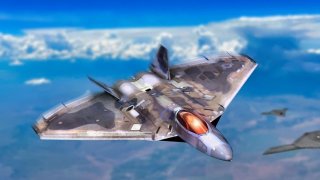NGAD: The Last U.S. Stealth Fighter Ever?
The Next Generation Air Dominance (NGAD) program offers the next evolution in a lineage of American-made fighters extending back over one hundred years. But is the era of the fighter jet about to end?
NGAD: The Last Stealth Fighter As We Know It Now? The upcoming Next Generation Air Dominance (NGAD) program offers the next evolution in a lineage of American-made fighters that extends back over one hundred years.
The lineage is distinguished, featuring early biplanes like the Martin NBS-1 and the Curtiss A-4 Falcon; World War Two era warbirds like the North American P-51 Mustang and the Republic P-47 Thunderbolt; Cold War interceptors like the North American F-100 Super Sabre and the Lockheed F-104 Starfighter; fourth-generation workhorses like the General Dynamics F-16 Fighting Falcon and McDonnell Douglas F/A-18 Super Hornet; and fifth-generation marvels like the Lockheed Martin F-22 Raptor and F-35 Lightning II.
The NGAD is billed as a sixth-generation successor to the F-22 Raptor, an air superiority platform that continues to push the technological boundaries of military aviation as American aerospace designers have been doing since the inception of flight.
But could the NGAD be a terminal design, the last true American fighter jet?
The future of flight and NGAD
Slowly but steadily, military aviation is trending towards unmanned airframes.
Sometimes, the unmanned airframes are remotely operated – still operated by a human, but a human who does not happen to be aboard the airframe while it is being operated. And sometimes, in more modern designs, the unmanned airframes are operated autonomously with artificial intelligence.
Remotely operated airframes, or drones, are not new. The US military has been remotely flying the MQ-9 Reaper and RQ-4 Global Hawk for two decades. The US Air Force has even converted some manned aircraft, the F-16, into unmanned aircraft, the QF-16 (likely to fly dangerous decoy missions).
The trend isn’t isolated to American designs, either. In Ukraine, low-cost kamikaze drones have been used with devastating effect to thwart the Russian advance. Actually, the cash-strapped Ukrainians hope to invest $1 billion to build a fleet of drones.
In the Red Sea, Iranian drones are pestering US Navy warships (which expend $2 million dollars in missiles to take out the numerous drones).
The increased presence of drones in the Red Sea harkens to long-hypothesized scenarios in which the Iranians could “swarm” US Navy warships with drones, effectively disabling the technologically superior warships.
The merits and the utility of drones are continuously being demonstrated, suggesting that drones are here to stay – a suggestion that the ongoing development of the NGAD corroborates.
Unmanned forthcoming for NGAD?
The NGAD program is built around two platforms. The first is a fighter jet known as the Penetrating Counter-Air (PCA), which will replace the F-22. The PCA will feature a cockpit, capable of hosting a human pilot – but the PCA likely won’t need the human pilot to operate; the PCA is expected to be operable in either manned or unmanned modes.
Complementing the PCA will be the NGAD’s second platform, the collaborative combat aircraft (CCA), also known as the “loyal wingman.” The CCA is an unmanned drone. Two CCA’s are expected to fly with each PCA (and with the F-35). So, America’s sixth-generation fighter could potentially be an unmanned jet with two autonomous drone wingmen – a stark departure from the US tradition of manned fighter aircraft, but in all likelihood, the future status quo. As Elon Musk boldly declared “the fighter jet era has passed.”
“The fighter jet era has passed,” Musk told AFA’s annual Air Warfare Symposium in 2020. “Locally autonomous drone warfare is where the future will be. I can’t believe I’m saying this, because this is dangerous, but it’s simply what will occur.”
Is the Fighter Jet Era Really Over?
I disagree that the fighter jet era has definitively passed. Fighter jets remain the foundation of modern air forces from Russia to China to the US. And fighter jets are still manned, nearly without exception.
“Advocates for unmanned and autonomous systems have trumpeted the end of manned aircraft for more than a decade, even as the Air Force has brought online its newest – and some suggest last – manned fighter jet, the F-35,” Air and Space Magazine reported. But the F-35 “will remain a centerpiece of its combat aviation forces for the foreseeable future.”
Still, while the fighter jet era has not passed, it may be passing – and the NGAD may be a milestone in that passing; the NGAD may accelerate the transition to unmanned platforms. Or perhaps, the NGAD will be used primarily or exclusively in unmanned mode, signaling that, indeed, the fighter jet era has passed (at least as far as the production of new American aircraft goes).
Fighter pilots are resistant to change, of course. “Air Force leaders argue it is more beneficial to keep a person in the cockpit because the algorithms that would let an aircraft think on its own aren’t sufficiently mature yet – not to mention the ethical dilemmas that come with waging war without a human present,” Air and Space Magazine reported.
The algorithms for purely autonomous flight may not be sufficiently developed in time for the release of the NGAD’s PCA fighter. But what about the next fighter? Safe money is on America’s seventh-generation fighter being autonomously operated.
In many respects, the era of the fighter jet as we know it could be coming to an end. Maybe.
About the Author
Harrison Kass is a defense and national security writer with over 1,000 total pieces on issues involving global affairs. An attorney, pilot, guitarist, and minor pro hockey player, Harrison joined the US Air Force as a Pilot Trainee but was medically discharged. Harrison holds a BA from Lake Forest College, a JD from the University of Oregon, and an MA from New York University. Harrison listens to Dokken.
Image Credit: U.S. Government/Creative Commons.


